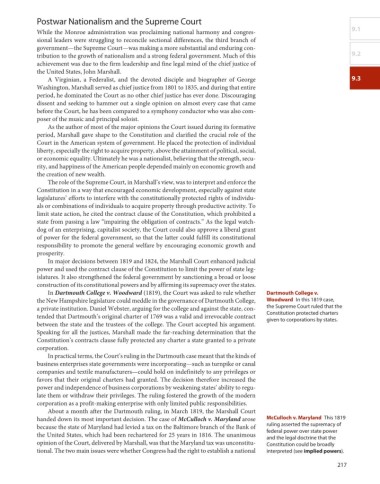Page 250 - American Stories, A History of the United States
P. 250
Postwar Nationalism and the Supreme court
While the Monroe administration was proclaiming national harmony and congres- 9.1
sional leaders were struggling to reconcile sectional differences, the third branch of
government—the Supreme Court—was making a more substantial and enduring con-
tribution to the growth of nationalism and a strong federal government. Much of this 9.2
achievement was due to the firm leadership and fine legal mind of the chief justice of
the United States, John Marshall.
A Virginian, a Federalist, and the devoted disciple and biographer of George 9.3
Washington, Marshall served as chief justice from 1801 to 1835, and during that entire
period, he dominated the Court as no other chief justice has ever done. Discouraging
dissent and seeking to hammer out a single opinion on almost every case that came
before the Court, he has been compared to a symphony conductor who was also com-
poser of the music and principal soloist.
As the author of most of the major opinions the Court issued during its formative
period, Marshall gave shape to the Constitution and clarified the crucial role of the
Court in the American system of government. He placed the protection of individual
liberty, especially the right to acquire property, above the attainment of political, social,
or economic equality. Ultimately he was a nationalist, believing that the strength, secu-
rity, and happiness of the American people depended mainly on economic growth and
the creation of new wealth.
The role of the Supreme Court, in Marshall’s view, was to interpret and enforce the
Constitution in a way that encouraged economic development, especially against state
legislatures’ efforts to interfere with the constitutionally protected rights of individu-
als or combinations of individuals to acquire property through productive activity. To
limit state action, he cited the contract clause of the Constitution, which prohibited a
state from passing a law “impairing the obligation of contracts.” As the legal watch-
dog of an enterprising, capitalist society, the Court could also approve a liberal grant
of power for the federal government, so that the latter could fulfill its constitutional
responsibility to promote the general welfare by encouraging economic growth and
prosperity.
In major decisions between 1819 and 1824, the Marshall Court enhanced judicial
power and used the contract clause of the Constitution to limit the power of state leg-
islatures. It also strengthened the federal government by sanctioning a broad or loose
construction of its constitutional powers and by affirming its supremacy over the states.
In Dartmouth College v. Woodward (1819), the Court was asked to rule whether Dartmouth college v.
the New Hampshire legislature could meddle in the governance of Dartmouth College, Woodward In this 1819 case,
a private institution. Daniel Webster, arguing for the college and against the state, con- the Supreme court ruled that the
tended that Dartmouth’s original charter of 1769 was a valid and irrevocable contract constitution protected charters
given to corporations by states.
between the state and the trustees of the college. The Court accepted his argument.
Speaking for all the justices, Marshall made the far-reaching determination that the
Constitution’s contracts clause fully protected any charter a state granted to a private
corporation.
In practical terms, the Court’s ruling in the Dartmouth case meant that the kinds of
business enterprises state governments were incorporating—such as turnpike or canal
companies and textile manufacturers—could hold on indefinitely to any privileges or
favors that their original charters had granted. The decision therefore increased the
power and independence of business corporations by weakening states’ ability to regu-
late them or withdraw their privileges. The ruling fostered the growth of the modern
corporation as a profit-making enterprise with only limited public responsibilities.
About a month after the Dartmouth ruling, in March 1819, the Marshall Court
handed down its most important decision. The case of McCulloch v. Maryland arose Mcculloch v. Maryland This 1819
because the state of Maryland had levied a tax on the Baltimore branch of the Bank of ruling asserted the supremacy of
the United States, which had been rechartered for 25 years in 1816. The unanimous federal power over state power
and the legal doctrine that the
opinion of the Court, delivered by Marshall, was that the Maryland tax was unconstitu- constitution could be broadly
tional. The two main issues were whether Congress had the right to establish a national interpreted (see implied powers).
217

